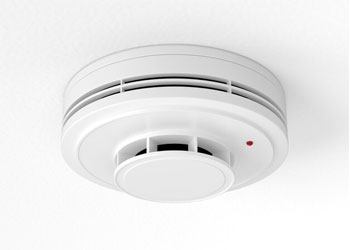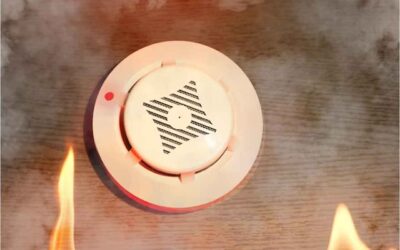Smoke detectors are essential in our homes to alert us to early fires, saving lives and property. They work by a continuous electrical charge and come in 2 options: battery-only or hardwired styles. Hardwired smoke detectors are now compulsory in new construction and home renovations, and they should be adopted widely even if the building code does not require them.
A hardwired smoke detector is an electrical device that uses a circuit cable to provide power to the detector, unlike the battery-powered ones. This power is provided by an unseen cable behind the detector, which continues to power it even in the event of a power failure. Here we learn how to Install Hardwired Smoke Detectors.
Before You Begin
Hardwired smoke detectors can be installed by splicing them into a general lighting circuit or outlet circuit, either a 15-amp circuit or a 20-amp circuit. The electrical code does not require a dedicated circuit for these detectors, but they can be connected to a new circuit. Wiring the smoke detectors is straightforward, with old-work electrical boxes installed at appropriate spots, a 2-wire cable running from the power source to the first smoke detector, and 3-wire cables linking the detectors in sequence. All standard precautions should be followed when working with electrical circuits, including shutting off power and testing for voltage before making any feed wire connections.
Tools You’ll need
- 6-foot extension ladder
- a measuring tape
- Pencil
- a stud finder
- The drywall saw
- cordless drill
- duct tape
- Ripper of cables
- Wire stripper
- Voltage tester
Materials
- Hardwired smoke detectors
- aged electrical boxes
- UL-listed wire connections
- 2-wire NM cable
- 3-wire NM cable
Instructions
Select one of the best places for smoke detectors. Because smoke rises, ceilings are often the best area for smoke detectors. Install the smoke detector within 12 inches of the ceiling if mounting it on a wall. The manufacturer’s instructions and your local building regulations will guide you to where the alarms should be installed.
1. Find the ceiling joists or wall studs using a stud finder. Hold the electrical box backward and create a cutout around its edges using the perimeter of its face as a template. When using old-work boxes, make sure to place them between joists or studs rather than on top of them.
2. Create cutouts
Cut openings in the drywall with a drywall saw to hold the electrical boxes for the smoke detectors. To set a starting point for the saw, you may need to drill a pilot hole.
3. Connect the NM Cable to the First Box
Run a 2-wire cable (with ground) from the power supply to the first box position. The power source could be in any of the following locations:
A previously installed wall outlet
A switch on the wall
A ceiling light fixture with a pass-through circuit cable that is not switched
The panel of circuit breakers
The most challenging component of the installation is generally fishing cable through walls. It may require some effort to determine the best route for the cables to go. Some electricians prefer to run cables up into attics, along ceiling joists, and then down into smoke detector boxes. This method may require extra cable, but it can make fishing the cables much easier.
Leave a substantial quantity of surplus cable extending through the hole in the drywall as you route the lines. During the installation, you will cut it to the right length.
4. Run Cables to Other Boxes
Beginning at the first smoke detector box location, run a 3-wire cable (with ground) to each subsequent smoke detector. The extra wire in these lines allows the smoke detectors to “talk” to one another so that when any of them detects smoke or fire, all detectors sound the alarm. Again, leave plenty of excess cables extending through the holes in the drywall.
5. Insert Cables into Electrical Boxes
To insert cables into electrical boxes, cut away excess cable, strip the outer sheathing, and insert the cables into the boxes. Strip away the outer sheathing using a cable ripper, ensuring 1/2 inch of cable insulation extends past the clamps. The way cables are clamped depends on the type of box, with some metal boxes requiring a cable clamp in knockout openings or internal clamps.
6. Assemble the boxes
Install each old-work box into the drywall opening, with cables secured in each box. Tighten the screws in the box to drag the retaining tabs up against the back of the drywall, securing it.
7. Install Mounting Plates
The smoke detector is installed using circuit wires through the mounting plate, connecting the screw holes with the electrical box’s holes, and using included screws to secure the plate to the box.
8. Connect the smoke detectors
Connect the smoke detector to the mounting plate using wire nuts or connectors. Connect black, white, and red circuit wires to the detector’s black, white, and ground wires. Secure the detector to the mounting plate, following the manufacturer’s directions. Slide notches into slots on the base and twist to secure the detector body.
9. Put in the backup smoke detector battery.
Insert the battery into the smoke detector, placing the positive and negative terminals correctly. Reinstall the cover.
10. Connect to the power source.
To connect a smoke detector to its power source, turn off the circuit and test for power. Open an outlet, light switch, or ceiling fixture box into the circuit wires. Splice into circuit wires not controlled by a wall switch, such as the black feed wire that feeds the switch. If installing a new circuit, install a new AFCI-protected circuit breaker to feed the smoke detectors.
11. Test the smoke detectors.
The smoke detectors should be tested properly. After installing, press the test button on each detector. All alarms should sound when the circuit is turned on. ensure the testing step personally.
Know When to Call a Professional
Hardwiring smoke detectors is an advanced electrical project that directly affects your safety. If you have any doubts about your ability to install these devices, contact a licensed electrician for assistance.
Even if the homeowner is quite comfortable installing the electrical boxes and running the cables, he or she may want to engage an electrician for the power source hookup, especially if it includes connecting to a new circuit breaker at the main service panel.

Image From Freepik
